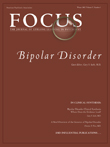Guideline Watch (November 2005): Practice Guideline for the Treatment of Patients with Bipolar Disorder, 2nd Edition
Abstract
APA’s Practice Guideline for the Treatment of Patients With Bipolar Disorder, 2nd Edition, was published in April 2002 (1). Since that time, a number of controlled treatment studies on aspects of bipolar disorder have been completed and published or are in press, including studies of second-generation (atypical) antipsychotics as monotherapy and as adjunctive treatment (with more traditional mood stabilizers) for the acute treatment of mania, studies of antiepileptic agents for the acute treatment of mania, trials for three medications for the acute treatment of bipolar depression, four monotherapy and one combination therapy relapse prevention studies, and studies of psychosocial interventions for maintenance. The evidence from these studies supports a substantially expanded set of options for clinicians who treat patients with bipolar disorder. This guideline watch briefly reviews the most important of the studies. The majority of the studies were industry supported.



